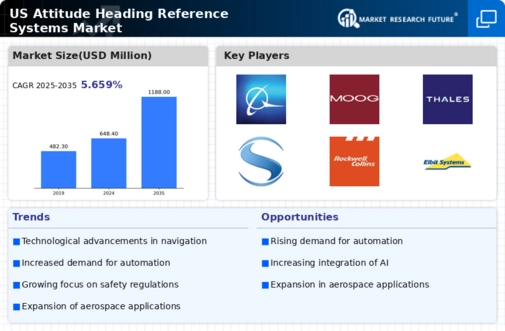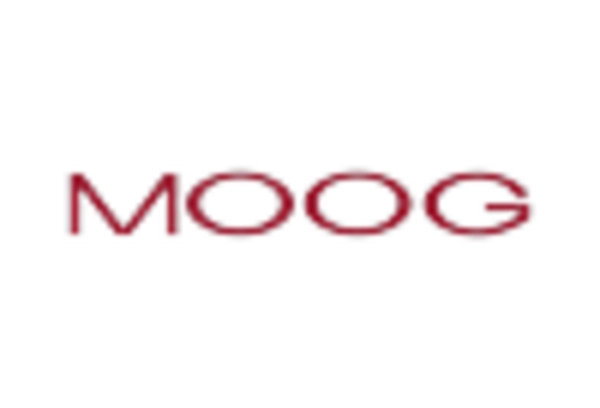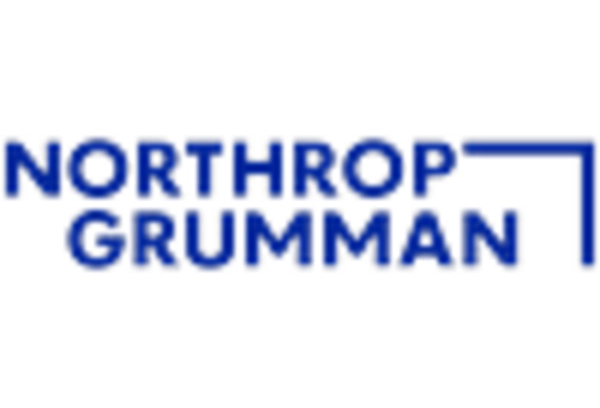The attitude heading-reference-systems market is currently characterized by a dynamic competitive landscape, driven by technological advancements and increasing demand for precision navigation solutions across various sectors, including aviation and maritime. Key players such as Honeywell International Inc (US), Northrop Grumman Corporation (US), and Garmin Ltd (US) are strategically positioned to leverage their innovative capabilities and extensive product portfolios. Honeywell International Inc (US) focuses on enhancing its digital transformation initiatives, while Northrop Grumman Corporation (US) emphasizes its commitment to advanced aerospace technologies. Garmin Ltd (US) is increasingly investing in consumer-oriented navigation solutions, which reflects a broader trend towards user-friendly applications in the market. Collectively, these strategies contribute to a competitive environment that is both robust and evolving, as companies seek to differentiate themselves through innovation and customer-centric solutions.
In terms of business tactics, companies are increasingly localizing manufacturing and optimizing supply chains to enhance operational efficiency and reduce costs. The market structure appears moderately fragmented, with several key players exerting influence over various segments. This fragmentation allows for niche players to emerge, while larger corporations consolidate their market positions through strategic partnerships and acquisitions. The collective influence of these key players shapes the competitive dynamics, as they navigate challenges and opportunities in a rapidly changing technological landscape.
In October 2025, Honeywell International Inc (US) announced a partnership with a leading aerospace manufacturer to develop next-generation attitude heading-reference systems that integrate artificial intelligence for enhanced accuracy. This strategic move is significant as it positions Honeywell at the forefront of innovation, potentially setting new standards for performance in the industry. The integration of AI is likely to attract a broader customer base seeking advanced solutions that offer improved reliability and efficiency.
In September 2025, Northrop Grumman Corporation (US) unveiled a new line of attitude heading-reference systems designed specifically for unmanned aerial vehicles (UAVs). This launch is indicative of Northrop Grumman's strategic focus on expanding its product offerings in the UAV sector, which is experiencing rapid growth. By catering to this emerging market, the company not only diversifies its portfolio but also strengthens its competitive edge in a niche that is expected to see increased demand in the coming years.
In August 2025, Garmin Ltd (US) expanded its product line to include advanced attitude heading-reference systems tailored for marine applications. This expansion reflects Garmin's strategy to penetrate the maritime sector, which is increasingly adopting sophisticated navigation technologies. By diversifying its offerings, Garmin positions itself to capture a larger share of the market, particularly as the demand for reliable navigation solutions in marine environments continues to rise.
As of November 2025, current competitive trends in the attitude heading-reference-systems market are heavily influenced by digitalization, sustainability, and the integration of AI technologies. Strategic alliances are becoming increasingly important, as companies collaborate to enhance their technological capabilities and market reach. Looking ahead, it is anticipated that competitive differentiation will evolve, shifting from traditional price-based competition to a focus on innovation, technological advancements, and supply chain reliability. This evolution underscores the necessity for companies to adapt and innovate continuously to maintain their competitive positions in a rapidly changing market.

















Leave a Comment